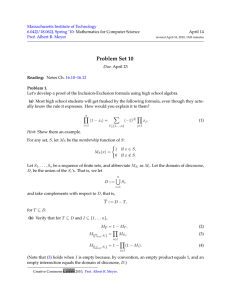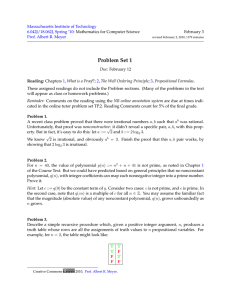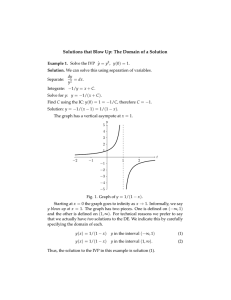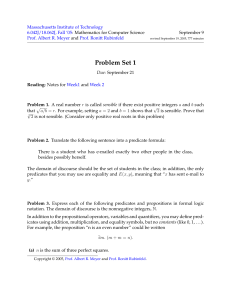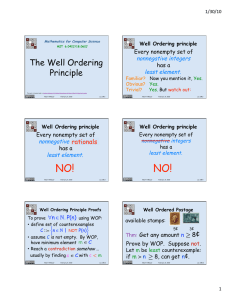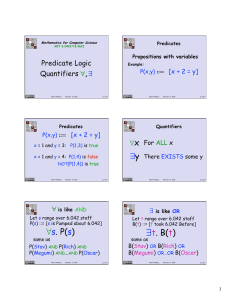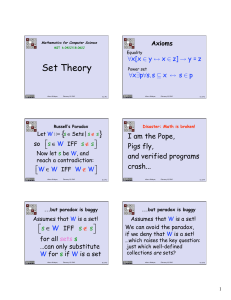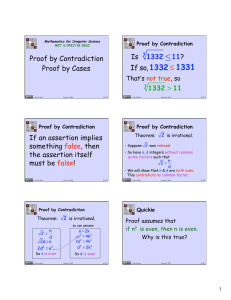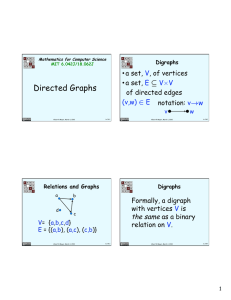Problem
advertisement
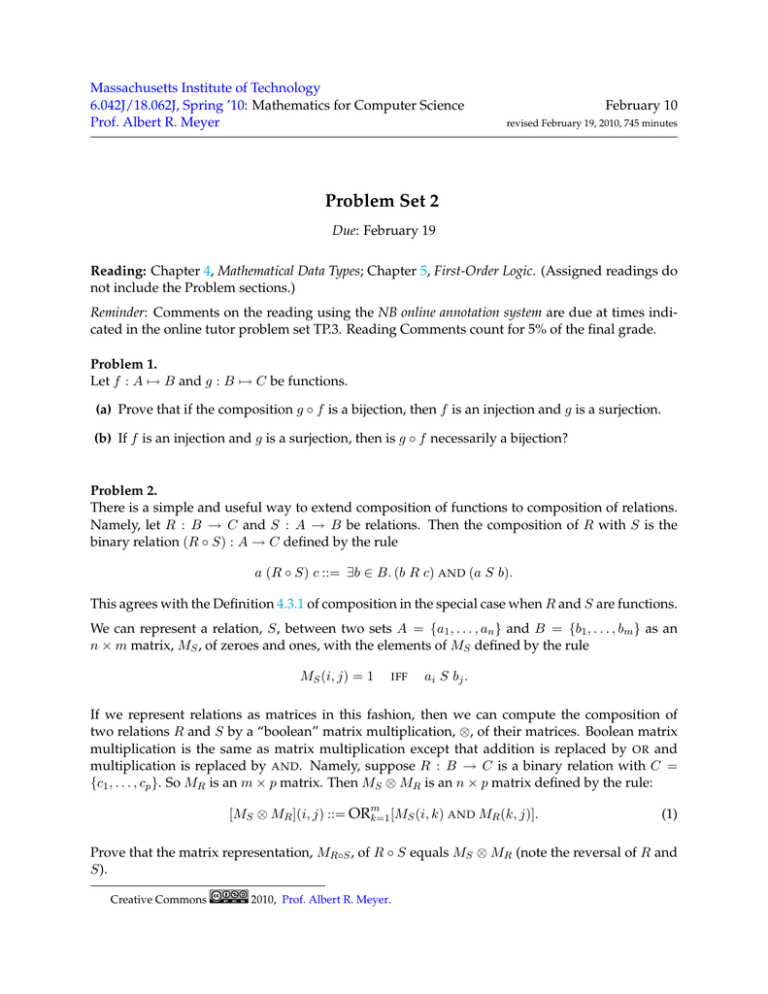
Massachusetts Institute of Technology
6.042J/18.062J, Spring ’10: Mathematics for Computer Science
Prof. Albert R. Meyer
February 10
revised February 19, 2010, 745 minutes
Problem Set 2
Due: February 19
Reading: Chapter 4, Mathematical Data Types; Chapter 5, First-Order Logic. (Assigned readings do
not include the Problem sections.)
Reminder: Comments on the reading using the NB online annotation system are due at times indi­
cated in the online tutor problem set TP.3. Reading Comments count for 5% of the final grade.
Problem 1.
Let f : A �→ B and g : B �→ C be functions.
(a) Prove that if the composition g ◦ f is a bijection, then f is an injection and g is a surjection.
(b) If f is an injection and g is a surjection, then is g ◦ f necessarily a bijection?
Problem 2.
There is a simple and useful way to extend composition of functions to composition of relations.
Namely, let R : B → C and S : A → B be relations. Then the composition of R with S is the
binary relation (R ◦ S) : A → C defined by the rule
a (R ◦ S) c ::= ∃b ∈ B. (b R c) AND (a S b).
This agrees with the Definition 4.3.1 of composition in the special case when R and S are functions.
We can represent a relation, S, between two sets A = {a1 , . . . , an } and B = {b1 , . . . , bm } as an
n × m matrix, MS , of zeroes and ones, with the elements of MS defined by the rule
MS (i, j) = 1
IFF
ai S bj .
If we represent relations as matrices in this fashion, then we can compute the composition of
two relations R and S by a “boolean” matrix multiplication, ⊗, of their matrices. Boolean matrix
multiplication is the same as matrix multiplication except that addition is replaced by OR and
multiplication is replaced by AND. Namely, suppose R : B → C is a binary relation with C =
{c1 , . . . , cp }. So MR is an m × p matrix. Then MS ⊗ MR is an n × p matrix defined by the rule:
[MS ⊗ MR ](i, j) ::= ORm
k=1 [MS (i, k) AND MR (k, j)].
(1)
Prove that the matrix representation, MR◦S , of R ◦ S equals MS ⊗ MR (note the reversal of R and
S).
Creative Commons
2010, Prof. Albert R. Meyer.
2
Problem Set 2
Problem 3.
The standard notation for the proposition that a set, x, is a member of a set, y, is
x ∈ y.
Formulas built up from membership formulas of this form using logical connectives and quanti­
fiers are called the logical formulas of set theory. For example, to say x �= y with a formula of set
theory, we could write
∃z (z ∈ x) XOR (z ∈ y).
(2)
(a) Write a formula of set theory that means that x is the empty set.
(b) Write a formula of set theory that means that x ⊆ y, that is, x is a subset of y.
(c) Write a formula of set theory that means that x ⊂ y, that is, x is a proper subset of y.
(d) Write a formula of set theory that means that y is the powerset of x.
(e) Write a formula, Three(y), of set theory that means that y has at least three elements.
(f) Write a formula of set theory that means that y has exactly two elements.
(g) A set, x, is member-minimal in a set y iff x is a member of y and no element of y is a member of
x. Write a formula, MM(x, y), of set theory that means that x is member-minimal in y.
(h) The Foundation Axiom of Zermelo-Fraenkel set theory asserts that every nonempty set has a
member-minimal element. Express the Foundation Axiom as a formula of set theory. (You may
use the formula MM(x, y) of part (g) as an abbreviation in your formula).
Problem 4.
Prove that for any sets A, B, C, and D, if A × B and C × D are disjoint, then either A and C are
disjoint or B and D are disjoint.
Massachusetts Institute of Technology
6.042J/18.062J, Spring ’10: Mathematics for Computer Science
Prof. Albert R. Meyer
Solutions cover sheet
February 10
Student’s Solutions to Problem Set 2
Your name:
Due date:
February 19
Submission date:
Circle your TA/LA:
Megumi
Tom
Richard
Eli
Collaboration statement: Circle one of the two choices and provide all pertinent info.
1. I worked alone and only with course materials.
2. I collaborated on this assignment with:
got help from:1
and referred to:2
DO NOT WRITE BELOW THIS LINE
Problem
Score
1
2
3
4
Total
Creative Commons
2010, Prof. Albert R. Meyer.
People other than course staff.
2
Give citations to texts and material other than the Spring ’10 course materials.
1
MIT OpenCourseWare
http://ocw.mit.edu
6.042J / 18.062J Mathematics for Computer Science
Spring 2010
For information about citing these materials or our Terms of Use, visit: http://ocw.mit.edu/terms.
